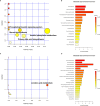Untargeted GC-MS-Based Metabolomics for Early Detection of Colorectal Cancer
- PMID: 34804922
- PMCID: PMC8599589
- DOI: 10.3389/fonc.2021.729512
Untargeted GC-MS-Based Metabolomics for Early Detection of Colorectal Cancer
Abstract
Background: Colorectal cancer (CRC) is one of the most common malignant gastrointestinal cancers in the world with a 5-year survival rate of approximately 68%. Although researchers accumulated many scientific studies, its pathogenesis remains unclear yet. Detecting and removing these malignant polyps promptly is the most effective method in CRC prevention. Therefore, the analysis and disposal of malignant polyps is conducive to preventing CRC.
Methods: In the study, metabolic profiling as well as diagnostic biomarkers for CRC was investigated using untargeted GC-MS-based metabolomics methods to explore the intervention approaches. In order to better characterize the variations of tissue and serum metabolic profiles, orthogonal partial least-square discriminant analysis was carried out to further identify significant features. The key differences in tR-m/z pairs were screened by the S-plot and VIP value from OPLS-DA. Identified potential biomarkers were leading in the KEGG in finding interactions, which show the relationships among these signal pathways.
Results: Finally, 17 tissue and 13 serum candidate ions were selected based on their corresponding retention time, p-value, m/z, and VIP value. Simultaneously, the most influential pathways contributing to CRC were inositol phosphate metabolism, primary bile acid biosynthesis, phosphatidylinositol signaling system, and linoleic acid metabolism.
Conclusions: The preliminary results suggest that the GC-MS-based method coupled with the pattern recognition method and understanding these cancer-specific alterations could make it possible to detect CRC early and aid in the development of additional treatments for the disease, leading to improvements in CRC patients' quality of life.
Keywords: GC-MS; cancer tissue and paracarcinoma tissue; colorectal cancer; metabolomics; preoperative and postoperative serum.
Copyright © 2021 Zhu, Wang, Wang, Shang, Pei, Zhao, Kong and Fan.
Conflict of interest statement
The authors declare that the research was conducted in the absence of any commercial or financial relationships that could be construed as a potential conflict of interest.
Figures







Similar articles
-
[Integrated analysis of serum untargeted metabolomics and targeted bile acid metabolomics for identification of diagnostic biomarkers for colorectal cancer].Nan Fang Yi Ke Da Xue Xue Bao. 2023 Mar 20;43(3):443-453. doi: 10.12122/j.issn.1673-4254.2023.03.15. Nan Fang Yi Ke Da Xue Xue Bao. 2023. PMID: 37087590 Free PMC article. Chinese.
-
[Screening of serum oxysterol biomarkers for colon cancer by liquid chromatography-tandem mass spectrometry].Se Pu. 2022 Jun;40(6):541-546. doi: 10.3724/SP.J.1123.2022.01001. Se Pu. 2022. PMID: 35616199 Free PMC article. Chinese.
-
Metabolomic Profiling Identified Serum Metabolite Biomarkers and Related Metabolic Pathways of Colorectal Cancer.Dis Markers. 2021 Dec 7;2021:6858809. doi: 10.1155/2021/6858809. eCollection 2021. Dis Markers. 2021. PMID: 34917201 Free PMC article. Clinical Trial.
-
The Application of Metabolomics in Recent Colorectal Cancer Studies: A State-of-the-Art Review.Cancers (Basel). 2022 Jan 30;14(3):725. doi: 10.3390/cancers14030725. Cancers (Basel). 2022. PMID: 35158992 Free PMC article. Review.
-
Global serum metabolomics profiling of colorectal cancer.Mol Clin Oncol. 2019 Jul;11(1):3-14. doi: 10.3892/mco.2019.1853. Epub 2019 May 8. Mol Clin Oncol. 2019. PMID: 31289671 Free PMC article. Review.
Cited by
-
Systematic Review: Contribution of the Gut Microbiome to the Volatile Metabolic Fingerprint of Colorectal Neoplasia.Metabolites. 2022 Dec 30;13(1):55. doi: 10.3390/metabo13010055. Metabolites. 2022. PMID: 36676980 Free PMC article. Review.
-
Serum Metabolomics Uncovers the Mechanisms of Inulin in Preventing Non-Alcoholic Fatty Liver Disease.Pharmaceuticals (Basel). 2024 Jul 5;17(7):895. doi: 10.3390/ph17070895. Pharmaceuticals (Basel). 2024. PMID: 39065745 Free PMC article.
-
Functional and embedding feature analysis for pan-cancer classification.Front Oncol. 2022 Sep 29;12:979336. doi: 10.3389/fonc.2022.979336. eCollection 2022. Front Oncol. 2022. PMID: 36248961 Free PMC article.
-
Study on potential markers for diagnosis of renal cell carcinoma by serum untargeted metabolomics based on UPLC-MS/MS.Front Physiol. 2022 Nov 29;13:996248. doi: 10.3389/fphys.2022.996248. eCollection 2022. Front Physiol. 2022. PMID: 36523562 Free PMC article.
-
LC-MS-based serum metabolomics analysis for the screening and monitoring of colorectal cancer.Front Oncol. 2023 Jun 28;13:1173424. doi: 10.3389/fonc.2023.1173424. eCollection 2023. Front Oncol. 2023. PMID: 37448516 Free PMC article.
References
LinkOut - more resources
Full Text Sources
Miscellaneous

